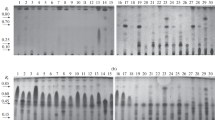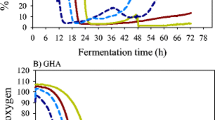Abstract
The impact of growing cultures of Paecilomyces fumosoroseus in liquid media containing four combinations of glucose and casamino acids (8 g l−1 or 80 g l−1 glucose, 1.32 g l−1 or 13.2 g l−1 casamino acids) was evaluated, based on blastospore production, germination rate, viability after freeze-drying and short-term storage stability. When blastospores were produced using a high casamino acid concentration, blastospore yields and germination rates were significantly higher (13.2–18.5×107 blastospores ml−1, 50–60% germination after 4 h), compared to cultures grown in media containing lower casamino acid concentrations (0.4–2.3×107 blastospores ml−1, 10–20% germination after 4 h). Chemical analyses of blastospore composition showed that accelerated blastospore germination may be related to increased proteinaceous reserves rather than to glycogen or lipid accumulation. Tolerance to freeze-drying by blastospores suspended in spent medium was enhanced by a high initial casamino acid concentration in the culture medium (75% survival) and by the residual glucose concentrations in the spent medium. Under the conditions of this study, the storage stability of blastospores of P. fumosoroseus was unaffected by the nutritional condition in which they were produced.


Similar content being viewed by others
References
Bellows TS, Perring JR, Gill RJ, Headrick DH (1994) Description of a species of Bemisia (Homoptera: Aleyrodidae). Ann Entomol Soc Am 87:195–206
Benny JF, Hennebert GL (1991) Viability and stability of yeast cells and filamentous fungal spores during freeze-drying: effects of protectants and cooling rates. Mycologia 83:805–815
Cliquet S, Jackson MA (1999) Influence of culture conditions on production and freeze-drying tolerance of Paecilomyces fumosoroseus blastospores. J Ind Microbiol Biotechnol 23:97–102
Crowe JH, Crowe LM, Carpenter JF, Aurell-Wistrom C (1987) Stabilization of dry phospholipid bilayers and proteins by sugars. Biochem J 242:1–10
Crowe LM, Crowe JH (1988) Effects of water and carbohydrates on membrane fluidity. In: Aloia RC, Curtain CC, Gordon LM (eds) Physiological regulation of membrane fluidity. Liss, New York, pp 75–99
Crowe JH, Carpenter JF, Crowe LM, Anchordoguy TJ (1990) Are freezing and dehydration similar stress vectors? A comparison of modes of interaction of stabilizing solutes with biomolecules. Cryobiology 27:219–231
Crowe JH, Crowe LM, Chapman D (1984) Preservation of membranes in anhydrobiotic organisms: the role of trehalose. Science 233:701–703
Fargues J, Maniania NK, Delmas JC (1994) Infectivity of propagules of Paecilomyces fumosoroseus during in vitro development to Spodoptera frugiperda. J Invertebr Pathol 64:173–178
Goettel MS, Roberts DW (1992) Mass production, formulation and field application of entomopathogenic fungi. In: Lomer CJ, Pror C (eds) Biological control of locusts and grasshoppers. CABI, Wallingford, pp 230–238
Hassan AEM, Dillon RJ, Charnley AK (1989) Influence of accelerated germination of conidia on the pathogenicity of Metarhizium anisopliae for Manduca sexta. J Invertebr Pathol 54:277–279
Hallsworth JE, Magan N (1995) Manipulation of intracellular glycerol and erythritol enhances germination of conidia at low water activity. Microbiology 141:1109–1115
Harman GE, Jin X, Stasz TE, Peruzzoti G, Leopold AC, Taylor AG (1991) Production of conidial biomass of Trichoderma harzianum for biological control. Biol Control 1:23–28
Inch JM, Humphrey AM, Trinci APJ, Gillespie AT (1986) Growth and blastospore formation by Paecilomyces fumosoroseus, a pathogen of brown planthopper (Nilaparvata lugens). Trans Br Mycol Soc 87:215–222
Jackson MA, Schisler DA (1992) The composition and attributes of Colletotrichum truncatum spores are altered by the nutritional environment. Appl Environ Microbiol 58:2260–2265
Jackson MA, Slininger PJ, Bothast RJ (1989) Effect of zinc, iron, cobalt, and manganese on Fusarium moniliforme NRRL 13616 growth and fusarin C biosynthesis in submerged cultures. Appl Environ Microbiol 55:649–655
Jackson MA, Bothast RJ (1990) Carbon concentration and carbon-to-nitrogen ratio influence submerged-culture conidiation by the potential bioherbicide Colletotrichum truncatum NRLL 13737. Appl Environ Microbiol 56:3435–3438
Jackson MA, McGuire MR, Lacey LA, Wraight SP (1997) Liquid culture production of desiccation tolerant blastospores of the bioinsecticidal fungus Paecilomyces fumosoroseus. Mycol Res 101:35–41
Jackson MA, Cliquet S, Iten LB (2003) Media and fermentation processes for the rapid production of high concentrations of stable blastospores of the bioinsecticidal fungus Paecilomyces fumosoroseus. Biocontrol Sci Technol 13:23–33
Jaronski ST (1986) Commercial development of deuteromycetous fungi of arthropods: a critical appraisal. In: Samson RA, Vlak JM, Peters D (eds) Fundamental and applied aspects of invertebrate pathology. (Fourth international colloquium on invertebrate pathology.) CABI, Wageningen
Lane BL, Trinci PJ, Gillespie AT (1991) Endogenous reserves and survival of blastospores of Beauveria bassiana harvested from carbon- and nitrogen-limited batch cultures. Mycol Res 95:821–828
Poprawski TJ, Jackson MA (1999) Laboratory activity of blastospores of Paecilomyces fumosoroseus on Bemisia argentifolii nymphs. Arthropod Manage Tests 24:399–400
Schisler DA, Jackson MA, Bothast RJ (1991) Influence of nutrition during conidiation of Colletotrichum truncatum on conidial germination and efficacy in inciting disease in Sesbania exaltata. Phytopathology 81:587–590
Smith P (1993) Control of Bemisia tabaci and the potential of Paecilomyces fumosoroseus as a biopesticide. Biocontrol News Info 14:71–78
Tan CS, Van Ingen CW, Talsma H, Van Miltenburg JC, Steffensen CL, Vlug IJA, Stalpers JA (1995) Freeze-drying of fungi: influence of composition and glass transition temperature of the protectant. Cryobiology 32:60–67
Vega FE, Jackson MA, McGuire MR (1999) Germination of conidia and blastospores of Paecilomyces fumosoroseus on the cuticle of the silverleaf whitefly, Bemisia argentifolii. Mycopathologia 147:33–35
Vega FE, Jackson MA, Mercadier G, Poprawski TJ (2003) The impact of nutrition on spore yields for various fungal entomopathogens in liquid culture. World J Microbiol Biotechnol 19:363–368
Vidal C, Fargues J, Lacey LA, Jackson MA (1998) Effect of various liquid culture media on morphology, growth, propagule production, and pathogenic activity to Bemisia argentifolii of the entomopathogenic hyphomycete Paecilomyces fumosoroseus. Mycopathologia 143:33–46
Wraight SP, Carruthers RI, Jaronski ST, Bradley CA, Garza CJ, Galaini-Wraight S (2000) Evaluation of the entomopathogenic fungi Beauveria bassiana and Paecilomyces fumosoroseus for microbial control of the silverleaf whitefly, Bemisia argentifolii. Biol Control 17:203–217
Wright MS, Connick WJ Jr, Jackson MA (2003) Use of Paecilomyces spp. as pathogenic agents against subterranean termites. US patent 6,660,291
Acknowledgements
The authors express their gratitude and recognize the significant technical contributions of Paula E. Becker and Angela R. Payne.
Author information
Authors and Affiliations
Corresponding author
Rights and permissions
About this article
Cite this article
Cliquet, S., Jackson, M.A. Impact of carbon and nitrogen nutrition on the quality, yield and composition of blastospores of the bioinsecticidal fungus Paecilomyces fumosoroseus. J IND MICROBIOL BIOTECHNOL 32, 204–210 (2005). https://doi.org/10.1007/s10295-005-0232-3
Received:
Accepted:
Published:
Issue Date:
DOI: https://doi.org/10.1007/s10295-005-0232-3




